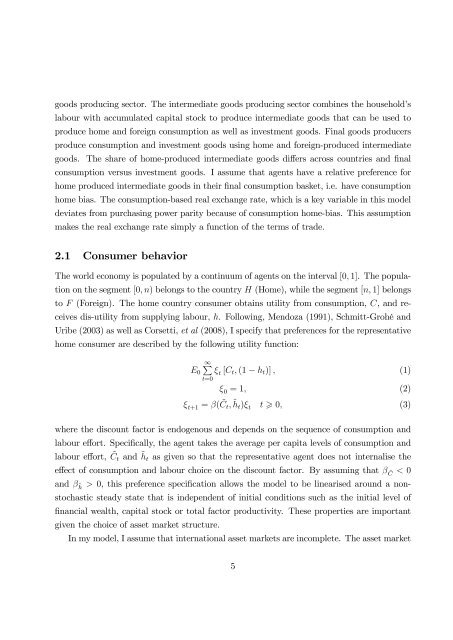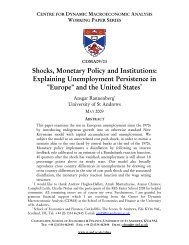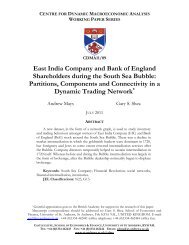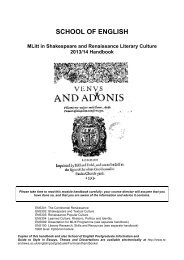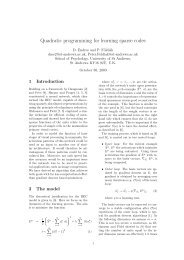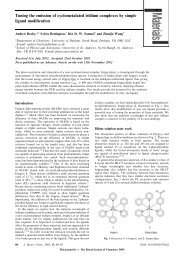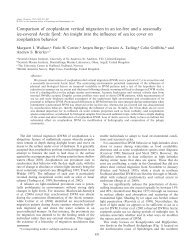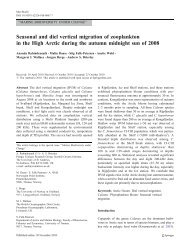Exchange rate dynamics, asset market structure and the role of the ...
Exchange rate dynamics, asset market structure and the role of the ...
Exchange rate dynamics, asset market structure and the role of the ...
You also want an ePaper? Increase the reach of your titles
YUMPU automatically turns print PDFs into web optimized ePapers that Google loves.
goods producing sector. The intermediate goods producing sector combines <strong>the</strong> household’s<br />
labour with accumulated capital stock to produce intermediate goods that can be used to<br />
produce home <strong>and</strong> foreign consumption as well as investment goods. Final goods producers<br />
produce consumption <strong>and</strong> investment goods using home <strong>and</strong> foreign-produced intermediate<br />
goods. The share <strong>of</strong> home-produced intermediate goods di¤ers across countries <strong>and</strong> …nal<br />
consumption versus investment goods. I assume that agents have a relative preference for<br />
home produced intermediate goods in <strong>the</strong>ir …nal consumption basket, i.e. have consumption<br />
home bias. The consumption-based real exchange <strong>rate</strong>, which is a key variable in this model<br />
deviates from purchasing power parity because <strong>of</strong> consumption home-bias. This assumption<br />
makes <strong>the</strong> real exchange <strong>rate</strong> simply a function <strong>of</strong> <strong>the</strong> terms <strong>of</strong> trade.<br />
2.1 Consumer behavior<br />
The world economy is populated by a continuum <strong>of</strong> agents on <strong>the</strong> interval [0; 1]. The population<br />
on <strong>the</strong> segment [0; n) belongs to <strong>the</strong> country H (Home), while <strong>the</strong> segment [n; 1] belongs<br />
to F (Foreign). The home country consumer obtains utility from consumption, C, <strong>and</strong> receives<br />
dis-utility from supplying labour, h. Following, Mendoza (1991), Schmitt-Grohé <strong>and</strong><br />
Uribe (2003) as well as Corsetti, et al (2008), I specify that preferences for <strong>the</strong> representative<br />
home consumer are described by <strong>the</strong> following utility function:<br />
1P<br />
E 0 t [C t ; (1 h t )] ; (1)<br />
t=0<br />
0 = 1; (2)<br />
t+1 = ( C ~ t ; h ~ t ) t t > 0; (3)<br />
where <strong>the</strong> discount factor is endogenous <strong>and</strong> depends on <strong>the</strong> sequence <strong>of</strong> consumption <strong>and</strong><br />
labour e¤ort. Speci…cally, <strong>the</strong> agent takes <strong>the</strong> average per capita levels <strong>of</strong> consumption <strong>and</strong><br />
labour e¤ort, Ct ~ <strong>and</strong> h ~ t as given so that <strong>the</strong> representative agent does not internalise <strong>the</strong><br />
e¤ect <strong>of</strong> consumption <strong>and</strong> labour choice on <strong>the</strong> discount factor. By assuming that ~C < 0<br />
<strong>and</strong> ~h > 0, this preference speci…cation allows <strong>the</strong> model to be linearised around a nonstochastic<br />
steady state that is independent <strong>of</strong> initial conditions such as <strong>the</strong> initial level <strong>of</strong><br />
…nancial wealth, capital stock or total factor productivity. These properties are important<br />
given <strong>the</strong> choice <strong>of</strong> <strong>asset</strong> <strong>market</strong> <strong>structure</strong>.<br />
In my model, I assume that international <strong>asset</strong> <strong>market</strong>s are incomplete. The <strong>asset</strong> <strong>market</strong><br />
5


